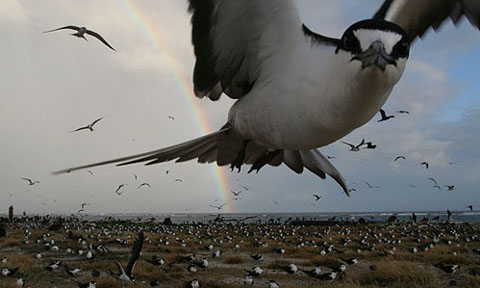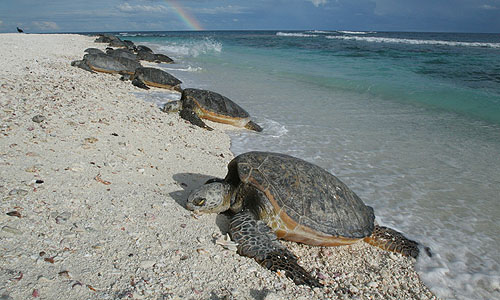by Joe Spring on 7 June 2007 in www.PlentyMag.com
Evidence of our actions is everywhere—even on a remote Pacific atoll.
Five years ago, I spent my summer crushing light bulbs. I worked alone and at night, when the pop and crunch of glass beneath my feet shattered the calm of darkness.
I camped on a six-acre, treeless burp of sand in the middle of the Pacific Ocean. My job, during June and July of that year and in the three summers since, involved circling the island from sunset to sunrise tagging threatened Hawaiian green sea turtles.
At night, hundreds of the 200-pound green reptiles crawled onto the island, where they threw sand behind them into two-foot-high mounds. They dug two-foot deep pits to lay their eggs, turning the island into a series of sand moguls.Having worked with sea turtles before, I expected as much. What I didn’t expect was all the trash: plastic bottles, laundry baskets, glass bottles, milk crates, fishing line, fishing buoys, fire extinguishers, large nets, fluorescent
tubes, and incandescent bulbs. Occasionally I stumbled over a bottle or crushed a bulb.
The bulbs told a story of how human actions affect even the farthest reaches of the planet. “It is good, at certain hours of the day and night to look closely at the world of objects at rest,” said Chilean poet Pablo Neruda. “From them flow the contacts of man with the earth, like a text for all troubled lyricists.”
Because of their remoteness, the Northwestern Hawaiian Islands have often been described as pristine. East Island, where I lived on the coral atoll of French Frigate Shoals, peaked out of the ocean more than 500 miles from the main Hawaiian islands and more than 2,000 miles from the nearest continent.
Artificial light did not pollute the night. Stars littered the sky like white specks on the inside of an upside down black bowl. Giant moonbows arched up from the horizon like massive cartoon mouse holes.
Wildlife abounded. Every morning 10-foot tiger sharks breached shallow, turquoise surf to snatch unsuspecting fledgling albatross. Golden 500-pound Hawaiian monk seals bore tiny, jet-black pups on the beach, their afterbirth staining the sand before being washed away by the tide. Thousands of seabirds filled the air with the thick smell of guano. Masked boobies, sooty terns, black albatross, and laysan albatross all laid their eggs on the sand. The turtles, crawling on
land to lay their own eggs, inadvertently crushed some of the birds’.

But this island is not pristine. People and their trash wear on the island in ways both acute and chronic. The nets and fishing line entangle and drown turtles, dolphins, and seals; the lighters and plastic bottle caps near the ocean’s surface feed seabirds that then fly hundreds of miles to regurgitate the food back to their young. Printed in English, Chinese, Arabic, and Spanish, the bottles tell of their distant sources.
Now, I understand there is a more powerful force affecting the island. It is less obvious than giant drift nets and worn glass bottles, and beyond the observations of poets. It is the result of miniscule changes over decades, centuries, and even millennia recorded by scientists that detail rising temperatures, carbon dioxide levels, and retreating ice.
The oceans are rising. Last June, as I trudged through sand and crawled behind turtles, President Bush protected the islands and their surrounding water in the most dramatic pro-environment moment of his presidency. Around the same time, scientists published a study that predicted the islands on the atoll could lose 65 percent of their land in the next 100 years due to a bloated Pacific.
Last week, almost one year later, Bush proposed a non-binding, international plan to reduce emissions. Skeptics say his plan takes away from international goals, while supporters point to it as a sign of hope. Whether his plan is beneficial or not, it represents another turn in his policy on climate change. To some extent, the turn just feels like political circling. Months after the Supreme Court ruled that the EPA has the authority to regulate greenhouse gas emissions
from cars, no decisive action has been taken. Still, it is a slight turn, certainly large enough to be noticed by a scientist, but lacking the starkness that would appeal to a poet's perception.
I can’t help thinking that Neruda’s observation should be twisted around and focused on minute changes beyond instantaneous human perception. Because humanity’s hand does not just wear on objects, it warms the earth, raises seas, and drowns islands. Slow and imperceptible as these effects might once have seemed, thanks to the generational observations of climatologists, human interference is now as obvious and disturbing as the political silence waiting
to be shattered under the mounting weight of science.
|

